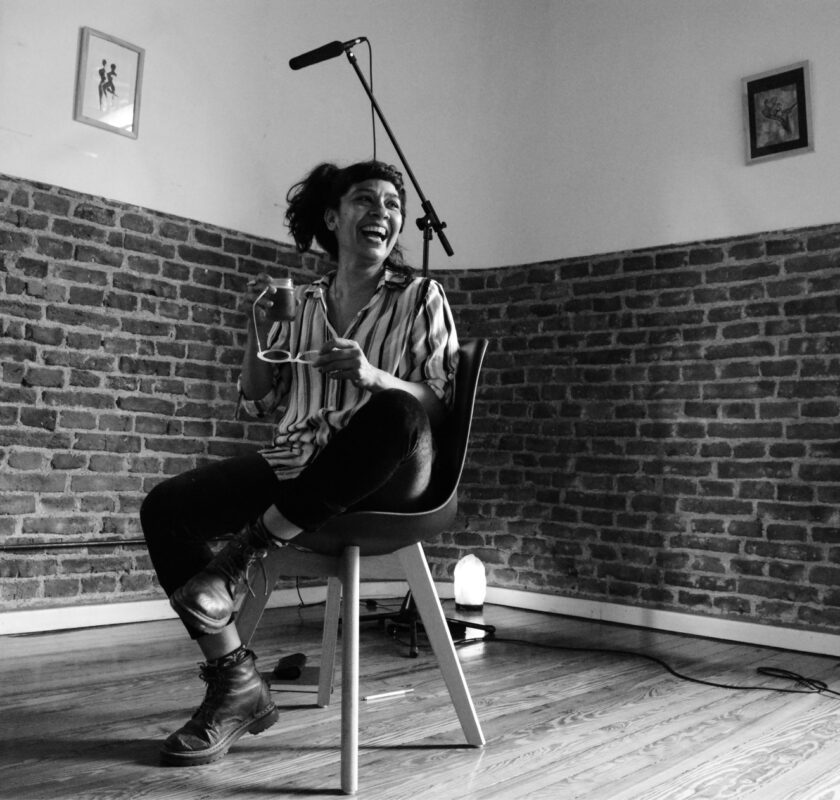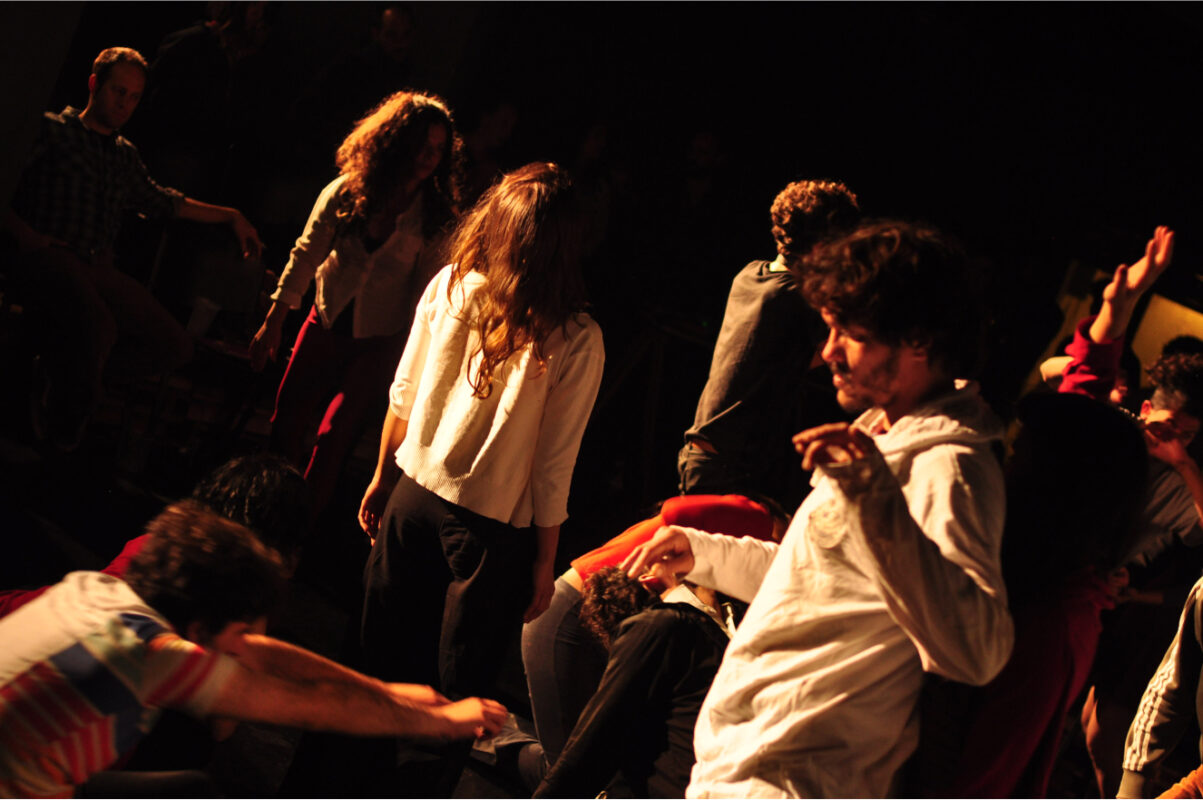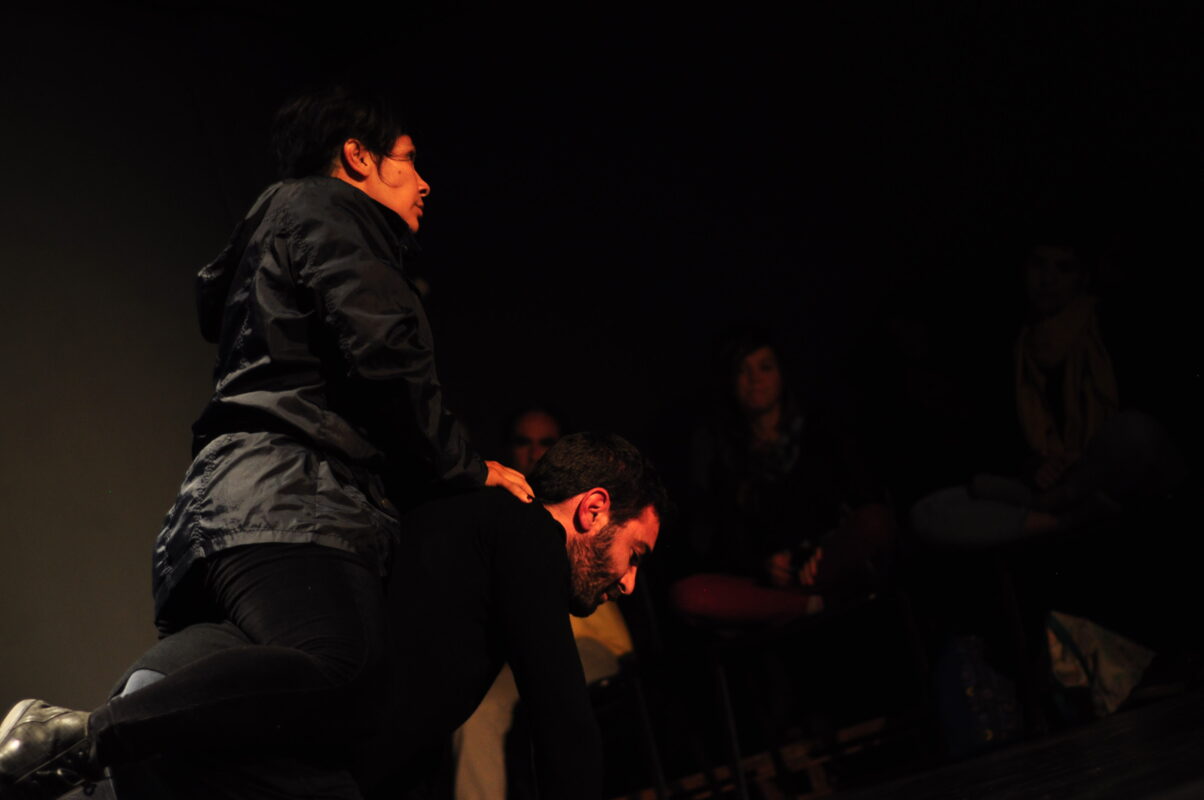
The Body that Shapes Dance
In my story, dance enters through candombe and Afro-Rioplatense culture. San Telmo appears, and it feels familiar – my father was Uruguayan. I was twenty-seven years old and studying Social Work. My encounter with candombe culture was so moving that I decided to leave my career and enroll at UNA (National University of the Arts), where I began studying for a degree in Body Expression in Composition and Improvisation. I entered the dance world from a very impulsive, intuitive place, almost defying the famous notion of “I’m too old for this.” There was a step-by-step approach to it. Whether from a creative perspective or as a student, I always seek the value of slowness. In candombe, we start with the feet – the foundation lies in the feet. From there, we gradually move up, and little by little, the spine and head come into play.
In 2007, I started teaching classes and incorporating the languages I had been exploring. I taught a candombe workshop related to body awareness. At that time, dance was more about observing someone else, something more traditional, focused on observation and imitation. During this period, I began to contemplate the body that shapes candombe dance, working with tools of body expression and sensory perception, considering the work of the feet and pelvis.
Candombe was a big bang in my life. It introduced me to dance and research simultaneously. It also led me to play drums and take photographs. I was constantly engaged in activities related to practice. For instance, I wrote for an Afro-culture magazine called “Revista Quilombo.” In 2013, I wrote my first paper, where I summarized the initial stage of my work, serving as a culmination of that process. Experiences at UNA introduced me to other incidents occupying my thoughts and feelings. Body expression began to take on a different dimension, and I had a significant encounter with Rhea Volij, one of my teachers.
My dance journey coincided with motherhood, studying at the university, and working from Monday to Friday. I became a mother at a very young age, at eighteen. My introduction to dance occurred during my early motherhood. At that time, I had the job I still hold today at the Manuel de Falla Conservatory of Music. It’s an administrative job requiring critical thinking and organization. It’s a job that has also allowed me the luxury of creating with minimal resources most of the time.
Throughout my practices, I’ve always discovered essential points of connection between different aspects of my life. Butoh also entered the picture as a significant practice I was engaged in, and in 2012, a pivotal moment that redirected my path occurred when I met Guillermo Angelelli. I underwent a process with him from March to December. The dynamic he offers is almost unheard of in Buenos Aires and Argentina: daily body and vocal training from Monday to Friday, three hours each day. It’s one of the most intense experiences I’ve had the privilege of going through, connected to theatrical anthropology.
The origin of dance also involves practices of feeling. The word “consciousness” comes into play – my constant search has always been about making the body and ancestral aspects conscious. They know the ritual and the importance of connecting with the people sharing the experience with me, whether collaborators in a creative process or students. The back-and-forth exchange is essential for what that person feels and what I think.

Improvisation: a conscious advocacy
Although it may seem ubiquitous, improvisation is a practice, and it is a practice of the future. It will continue to gain prominence because it allows for greater freedom regardless of the medium. Improvisation engages my subjectivity, everything that I am, was, or still am. In improvisation, I found the opportunity to play. When I say “improvisation,” I speak more from the perspective of an improvisational dancer and performer rather than a stage director. As a performer and practitioner, improvisation allows me to explore all the facets of my identity: dance, theater, Afro culture, intensity, words, and writing.
The format of the candombe takes place in public spaces. It can be circular; it can revolve around a fire. It’s a collective performance that involves the audience. I incorporated that into my latest project, “Indómita Performance:” – the fusion of dance with music and improvisation, drawing from more contemporary practices. Contemporary in an artistic sense is not necessarily tied to a specific time and place because candombe is very much alive in the present day.

In “Indómita“, I served as a curator performer and even handled promotion. Just before the pandemic, we were in the process of relocating to a new space called Movaq. There was something beautiful about the live events, about sharing networking. Improvisation was finding a place, and the audience and participants were actively involved. Then, the pandemic hit, and everything shut down. At that time, the team also included Paula Ligüero, a photographer; Verónica Rodríguez, who collaborated with me at the beginning; and Andrés Velázquez, responsible for the lighting. We had to figure out what to do. In 2019, I received a grant from the Metropolitan Fund – the first time I had won – and another from Prodanza. While it was minimal – thirty thousand pesos and the six audiovisual pieces were produced with seventy thousand – if we didn’t continue, “Indómita” would have to cease.
Dancing and improvising it was something that was happening a lot on social media. I thought, “I’m unsure if ‘Indómita‘ will make sense.” It was one of the most complex decisions because I was missing a significant part: the audience. We wondered how we would proceed without that. I like to be conscious of improvisation; it’s an advocacy. So, we came up with the idea of sharing the inner workings of what happens behind the scenes. When you see a dancer and a musician interacting in a performance, creating each other, that physical, intuitive, and energetic exchange is incredible. But what you see also has a foundation in thoughts, tensions, decisions, and limitations. So, we thought, “Let’s share this setup, let’s reveal what goes on, what an improviser thinks and feels.” That’s when the idea of starting with questions emerged, something prevalent in “Indómita” – asking questions more than providing answers.
Here, my origins come into play, the many practices that have always helped me navigate moments of crisis. I had experience conducting interviews and thinking deeply about improvisation. At such a moment, we resorted to filming. We found ourselves using an unfamiliar medium to me. But sometimes, territories are closer than we think. Embracing frustration means connecting with the present and what is possible. If we could connect more with that, we would live happier lives. It’s an ideal, and bringing it down to earth is quite challenging, but when it happens, it’s incredible. On the other hand, these reinventions are mysterious. It was beautiful and fortunate to encounter a team without one pulling in different directions.

Exploring new ways of creating
In my story, when I think about management, I realize that I began writing my projects when I couldn’t afford to pay someone else. It was a self-taught process that unfolded naturally. I enjoyed writing a lot; it was fantastic because it added depth to my work. I have conflicting feelings regarding management and self-management because I’m in a crisis.
On the one hand, connecting with people and artists is essential. I recently attended a management seminar, and it was beautiful to share that experience to articulate our thoughts and words about what we do. Naming myself as a manager and coming together to find new ways of working is a unique experience. These encounters also give us a sense of empowerment because, within the institutional framework, there are still significant gaps between what those of us engaged in creative work are thinking and what we are putting into practice, being fully available, attentive, and open while we create. It’s interesting to see that I’m not alone; there are many of us thinking about new ways of working.
However, the reality is that, during this quarantine period, I’m taking on something monumental. I’m exhausted, and managing everything drains my energy as a dancer and a dance practitioner. I spend a lot of time writing in front of the computer, and I’ve been applying for grants that have yet to be successful. I’m in a crisis, reevaluating myself. But connecting with others going through similar struggles has given me hope.

A community-Based Solution
These are times of exposed fragility. If there is a way out, I see it through community involvement. My participation in the “Frente Emergente de la Danza” (Emerging Dance Front) helped me shape this idea: that there are more extensive networks with different structures. For those of us who have been creating either independently or in small teams, it’s becoming more complicated. It’s helping me think about the collective, the communal, and the networks. Alternative paths won’t be feasible.
On the other hand, it’s important to continue highlighting the complexity of productions and creative endeavors. I’m thinking about how creativity will unfold from now on. I’m also considering the privilege of people with significant financial resources in the arts. My socioeconomic situation concerns me, my unique story, and I ponder what production means to us. For example, you need money for good sound and visuals in audiovisual work. As a community, think about strategies to collaborate. It’s a give-and-take; we are moving toward society, but it takes effort because we are in that transition. Some of us might need to learn how to operate in a community, or it might take time. We are learning.

It’s essential to make the importance of artistic practices for humanity visible, the significance of dance. I feel what dance has done for me, and I’ve seen how it helps others transform, feel better, and empower themselves. It’s invaluable; it’s health, and it’s love. Dance has something to tell me, telling me not to forget to feel. It’s crucial to integrate thinking, but what dance is telling me today is to return to the body, to return to feeling.